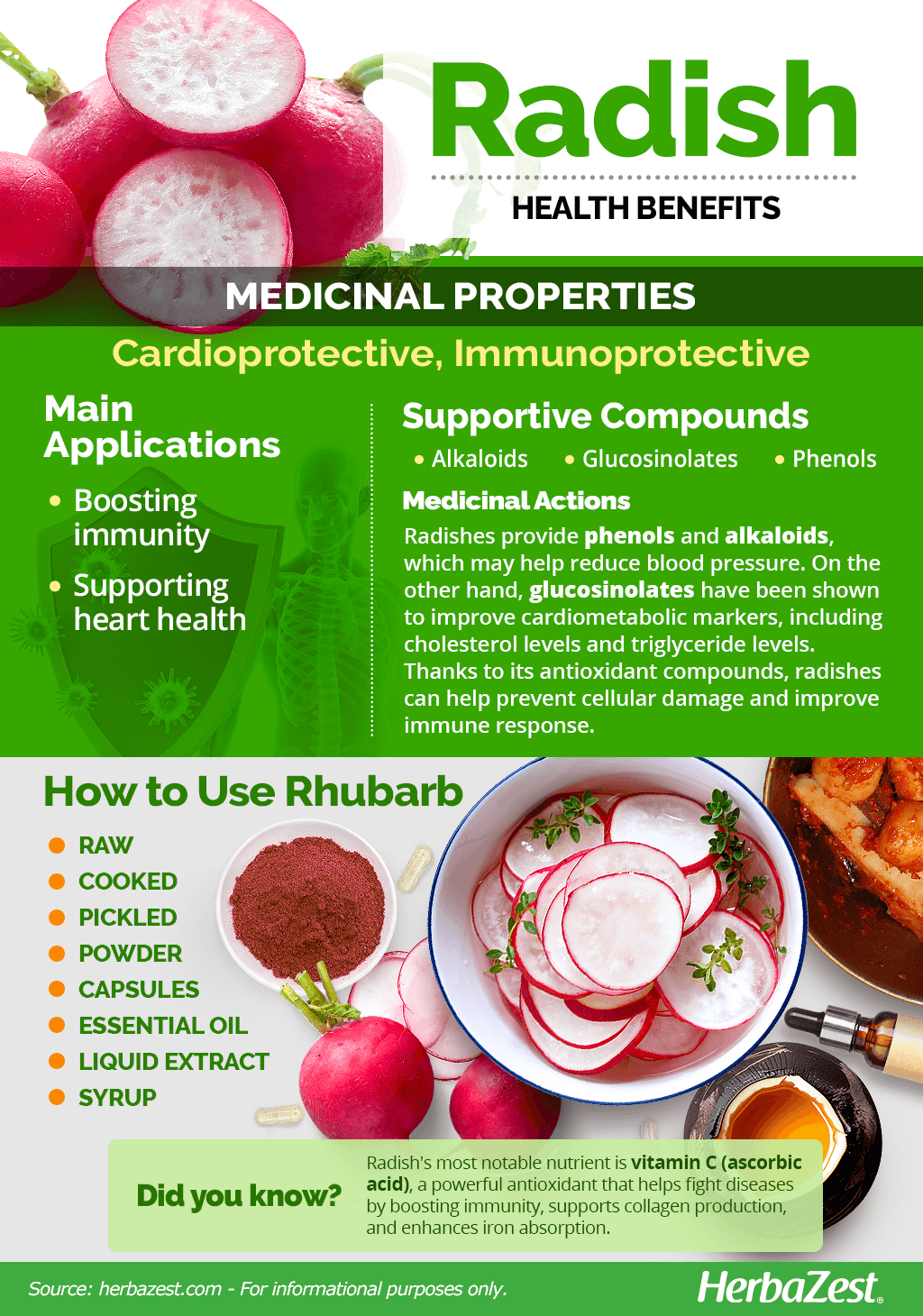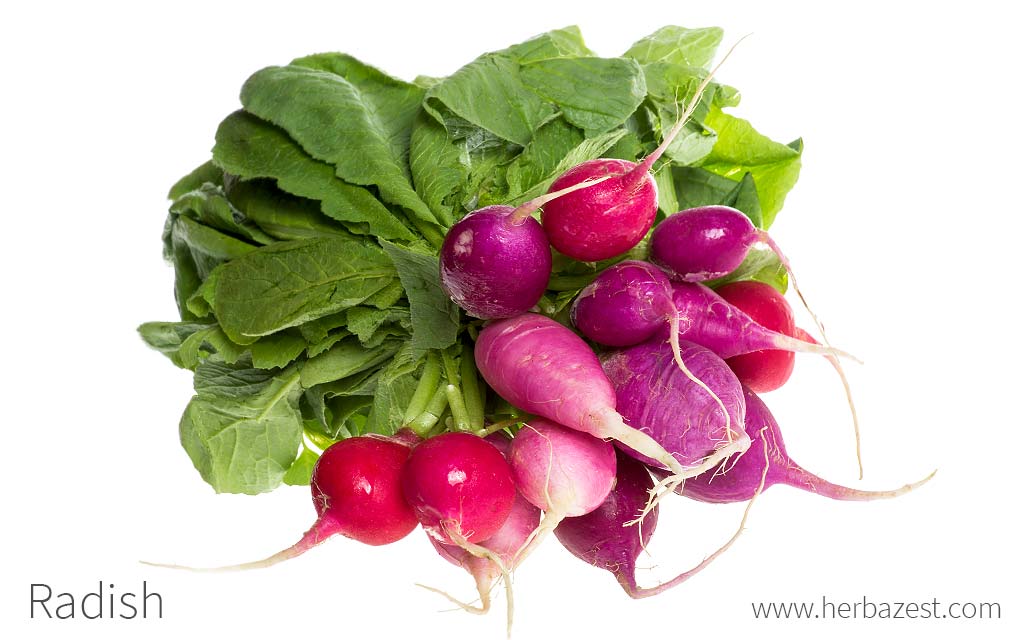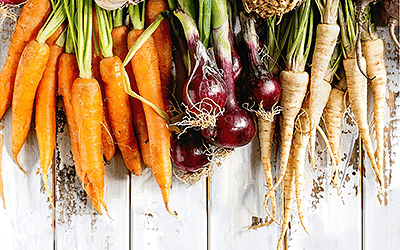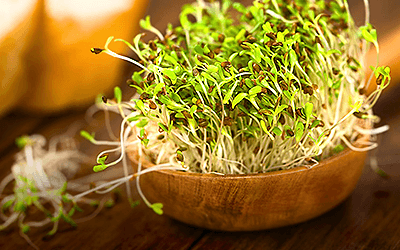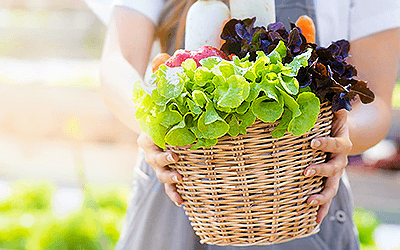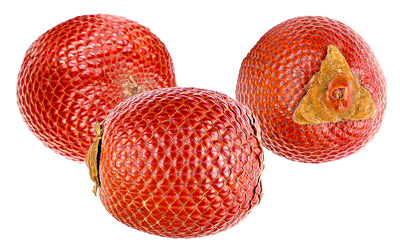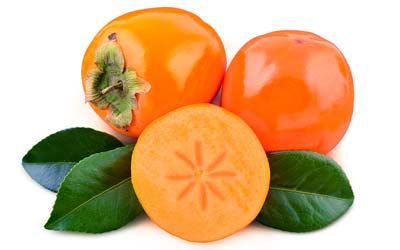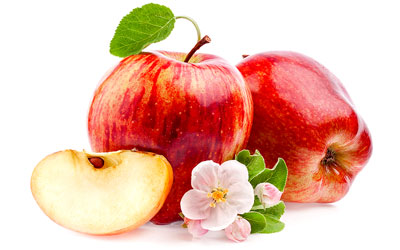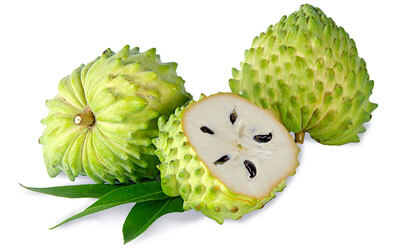Native to Asia and Europe, radish, also known as common radish and garden radish, has been historically consumed in both culinary and medicinal ways by all major civilizations, including the Egyptians, Chinese, Greeks, and Romans. Today, scientific studies have corroborated many traditional uses of radish, shedding light on its nutritional value and medicinal properties.
Radish Medicinal Properties
- Medicinal action Cardioprotective, Immunoprotective
- Key constituents Alkaloids, glucosinates, and phenols
- Ways to use Capsules, Liquid extracts, Food, Powder, Syrup, Essential oil
- Medicinal rating (2) Minorly useful plant
- Safety ranking Safe
Health Benefits of Radish
The leaves, seeds and root of radish have a long history of therapeutic use, particularly in Traditional Chinese Medicine (TCM). A large body of studies has analyzed the chemistry and mechanisms behind the health benefits of radish, suggesting that it may be especially useful for:
Boosting immunity. Radishes' antioxidant content may help strengthen immunity against foreign pathogens and degenerative diseases caused by oxidative damage.
Supporting heart health. Radish's bioactive compounds have been shown to reduce cholesterol and protect cardiovascular function, making it an ally in the dietary management and prevention of heart-related conditions.
Additional radish benefits include:
Improving digestion. Thanks to their rich dietary fiber content, radishes support digestion and help regulate bowel movements.
Controlling blood sugar levels. Eating raw radish roots delay glucose absorption after meals, helping reduce post-meal sugar spikes.
Promoting skin health. Radishes' antioxidant properties protect skin cells from free radical damage, and their antibacterial effects may also help treat skin conditions. 1,2
In TCM, dried radish seeds are used to treat constipation, chronic tracheitis, and hypertension.
How It Works
Radish's main active compounds are alkaloids, glucosinolates, and phenols, all of which are responsible for its therapeutic effects.
Radish extracts have been shown to increase nitric oxide levels and cytokine production while also preventing oxidative cellular damage. These findings suggest radish's potential as an immunomodulatory agent.3
Phenols and alkaloids may help reduce blood pressure, while glucosinolates have been shown to improve cardiometabolic markers, including cholesterol levels and triglyceride levels.4,5
Radish leaves and roots also have antimicrobial and antiviral propertiesand have traditionally been used to treat liver and respiratory conditions.
Other herbs that are beneficial for the immune function are camu camu, cherry, and cat's claw; whereas cardioprotective benefits can be obtained from buckwheat, kaniwa, leek, and walnut.
Side Effects & Cautions
Radishes are considered safe when consumed in culinary ways and in moderation; however, they can cause stomach discomfort, gas, and cramps if eaten in excess.
People with radish allergy can show a mild to severe immune response after ingestion, including itchy, tingling and swollen mouth and throat, abdominal pain, diarrhea, nausea, and vomiting as well as skin rash, hives, swelling and eczema.
Additionally, individuals with thyroid disorders should be aware that radishes also carry substances called goitrogens, which can interfere with the production of thyroid hormones.
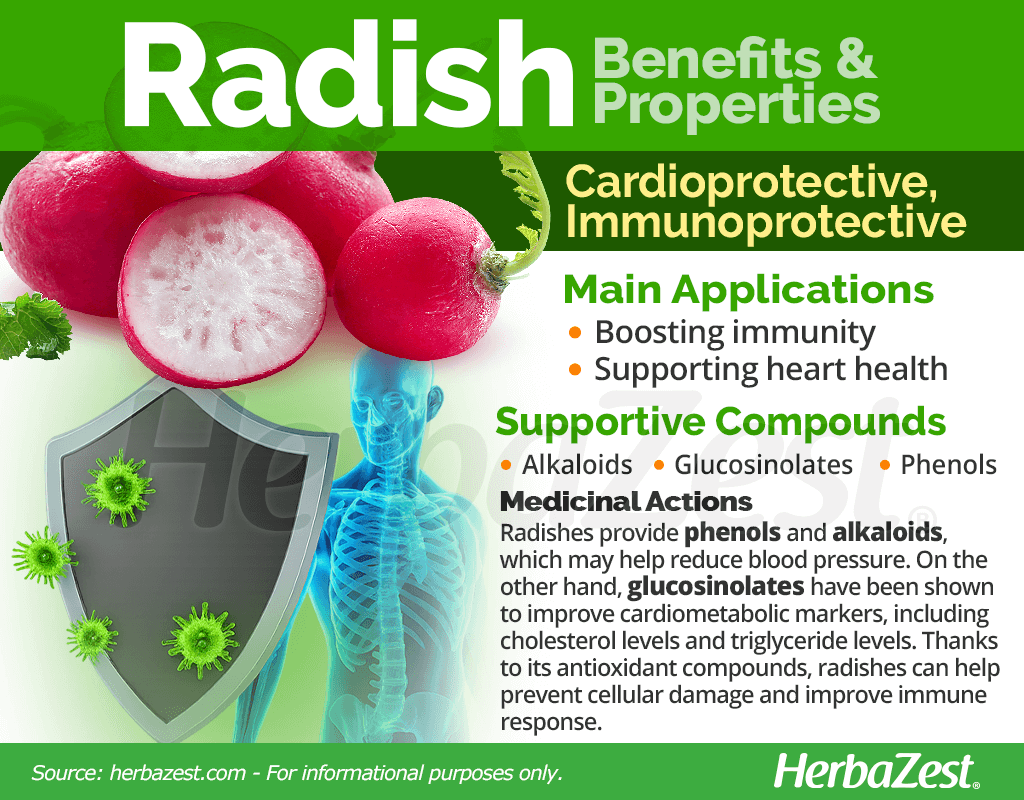
Radish Nutrition
Radishes are not among the most nutrient-dense vegetables; however, they are low in carbohydrates and a good source of dietary fiber, also providing small but valuable amounts of essential vitamins and minerals.
The juicy, crunchy radish root offers a good amount of potassium, which is essential for electrolyte balance and for transmitting the electrical signals that control muscle contraction. Potassium deficiency can lead to painful muscle cramps, weakness, and irregular heartbeats (arrhythmia). Radishes also provide moderate amounts of copper, a trace mineral important for energy production, iron absorption, collagen formation, and nerve function. In addition, they contain small amounts of other minerals, including calcium, iron, magnesium, phosphorus, zinc, and manganese.
Radish's most notable nutrient is vitamin C (ascorbic acid), a powerful antioxidant that strengthens the immune function, supports collagen production, enhances iron absorption, and helps protect against disease.
100 grams of radish provide 16 calories, 6% DV of dietary fiber, and only 1% DV of carbohydrates.
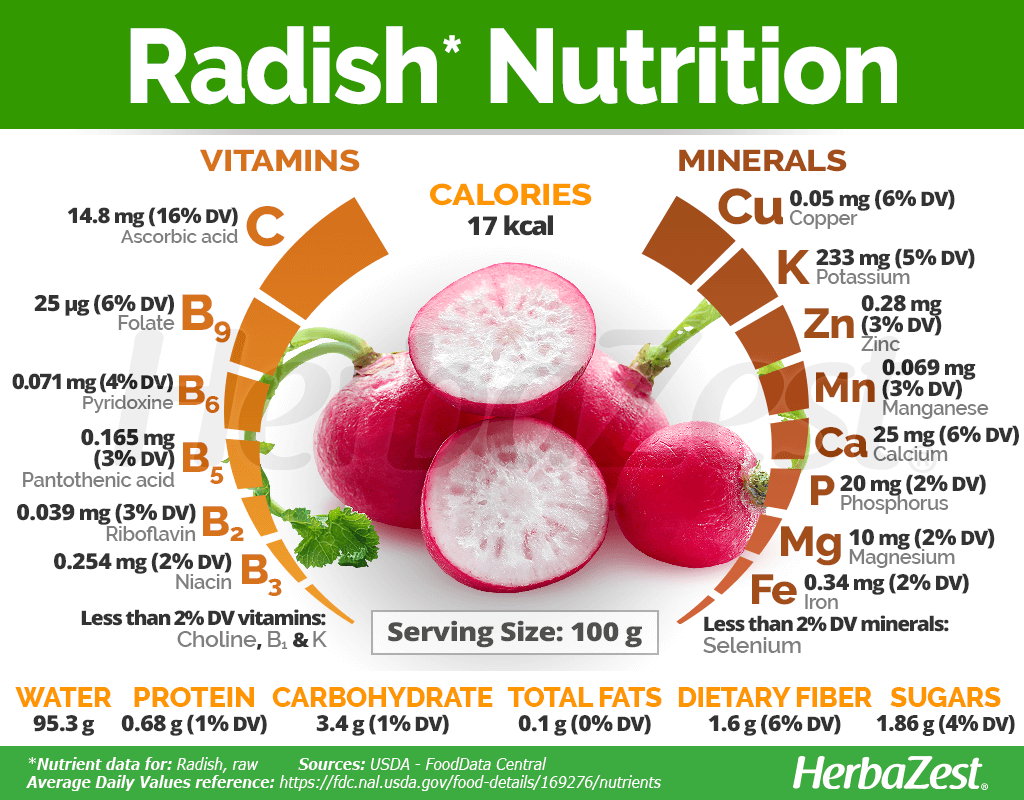
How to Consume Radish
- Edible parts Flowers, Leaves, Root, Seedpod
- Edible uses Condiment
- Taste Spicy
All parts of the radish plant - roots, leaves, and pods - are used in culinary recipes. Radishes have also been traditionally consumed in medicinal preparations and have proven effective for various health concerns.
Natural Forms
Raw. Radish roots, leaves, flowers, and pods are popular in salads, adding crunch and dietary fiber for better digestion, along with vitamin C, a powerful antioxidant.
Cooked. Radish leaves and pods can be lightly sautéed like other greens to retain their nutrients. Cooking radish roots reduces their peppery flavor.
Pickled. The crunchy texture of radish roots makes them ideal for preserves alongside other pickled vegetables.
Powder. Radish powder has many culinary uses. It can be sprinkled to salads and soups as a flavor enhancer, and it adds vibrant color and flavor to baked goods and beverages.
RADISHES WILL KEEP FRESH IN THE REFRIGERATOR FOR ONE TO TWO WEEKS. AFTERTHAT, THEY WILL BEGIN TO LOSE MOISTURE AND BECOME WRINKLED.
Herbal Remedies & Supplements
Liquid extract. With anti-inflammatory and antimicrobial properties, radish liquid extract support digestive and metabolic health as well as help relieve respiratory conditions such as colds and cough.
Oil. Radish seed oil has emollient and antibacterial properties and can be used for common skin conditions like acne, dried skin, eczema, and fungal infections, as well as for scalp and hair care.
Syrup. Radish syrup is a traditional remedy for boosting immunity and treating respiratory conditions, especially cough and colds.
Capsules. Radish is also available in convenient capsule form, commonly marketed for liver and digestive support, as well as for managing metabolic and respiratory conditions.
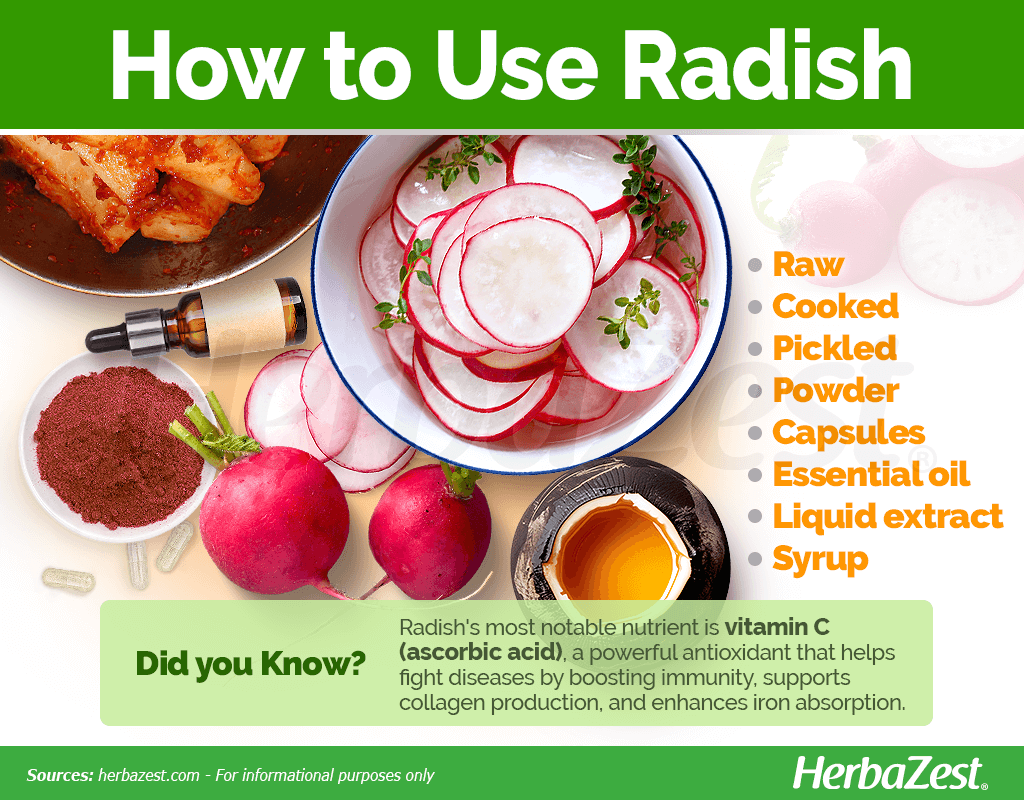
Growing
- Life cycle Annual
- Harvested parts Flowers, Roots, Seeds, Leaves
- Light requirements Full sun
- Soil Loamy sand, Well-drained
- Soil pH 6.6 – 7.3 (Neutral)
- Growing habitat Cool temperate regions
- USDA Plant Hardiness Zones 2a, 2b, 3a, 3b, 4a, 4b, 5a, 5b, 6a, 6b, 7a, 7b, 8a, 8b, 9a, 9b, 10a, 10b, 11a, 11b
- Pre-germination seed treatment None
- Planting time Late summer, Right after last frost
- Plant spacing average 0.1 m (0.30 ft)
- Growing time 25-45 days
- Potential insect pests Aphids, Nematodes, Cabbage loopers, Flea beetles, Root maggots
- Potential diseases Mildew, Root rot, Rust, Bacterial leaf spot, Damping-off
Radishes are well-suited for small gardens or containers. These hardy, fast-growing vegetables thrive in cool climates and altitudes between 623 and 4,068 feet (190-1,240 m), making them an ideal seasonal crop. They require minimal care but do need proper soil, temperature, and irrigation conditions.
Growing Guidelines
The radish plant is highly adaptable, and it can be cultivated in different types of soils. It thrives in loamy sand soil, with a pH between 6.5 and 7.0.
To ensure good drainage and germination, till the topsoil 6-12 inches (15-30 cm) deep.
- Gardening tip
For family consumption, 3-5 feet (91-152 cm) of row per person will provide enough fresh radishes. Ten linear feet (3 m) can produce about 10 bunches.
Radish is generally grown from seeds, which are sown 1/2-1 inch (1.3-2.5 cm) deep, spaced 1-3 inches (2.5-8 cm) apart, with rows 12 inches (30 cm) apart.
A cool-season crop, radish grows best in temperatures between 40-70°F (4-21°C), ideally between 60-65°F (16-18°C).
Plant in late winter, 2 or 3 weeks before the last frost, or in late summer for a fall harvest.
Depending on variety, radishes mature 25-45 days after seeding.
Moderate watering is best. Keep the soil moist without waterlogging, which may cause lodging or root rot.
Radish may be affected by diseases like root rot, damping-off, mildew, bacterial leaf spot, and white rust, as well we pests like aphids, cabbage loopers, nematodes, root maggots, and flea beetles.
Additional Information
- Other uses Cosmetics, Repellent
Plant Biology
Radish is a popular annual crop that typically grows in temperate to cool climates. This hardy vegetable reaches 12-35 inches (30-90 cm) in height. Its thick roots come in various sizes and shapes, mostly spherical or carrot-like, and in a wide range of colors, including green, white, pink, red, purple and yellow. The light green leaves grow in a rosette formation and measure 2-12 inches (5-30 cm) long. They are oblong, with rounded edges and a lanceolate center. Radish's small, inconspicuous flowers, usually purple or pink, grow in racemes and later develop into seed pods. These pods, long, pointed, and curved at the end, are harvested in their immature stage for culinary use. When fully matured, the pods produce between 2 and 12 seeds that are reddish, oval-shaped, and slightly flattened.
Classification
Radish (Raphanus sativus) belongs to the Raphanus genus and is a member of the Brassicaceae family (formerly Cruciferae), which includes about 360 genera and over 3,709 species. Many of these are valued for their medicinal, nutritional, and economic importance, such as arugula (Eruca sativa), broccoli (Brassica oleracea), Brussels sprouts (Brassica oleracea var. gemmifera), cabbage (Brassica oleracea var. capitata), cauliflower (Brassica oleracea var. botrytis), kale (Brassica oleriaceae var. acephala), and mustard (Brassica spp.). These are collectively known as cruciferous vegetables.
Varieties of Radish
The Raphanus genus includes only two species: Raphanus sativus, also known as garden radish, spring radish, winter radish, red radish, and common radish; and Raphanus raphanistrum, or wild radish. There are three radish varieties: R. sativus var. radicula, or garden radish, with a rounded shape, bright red skin, and a juicy, crisp interior; R. sativus var. longipinnatus is an Asian radish, commonly known as daikon, which is white, with a turnip-like appearance and a mild flavor; and R. sativus var. sativus (also known as R. sativus var. niger), or black radish, with a large root that can be rounded or elongated, black skin, and white flesh. Additionally, there are over a hundred commercial radish types, which come in a wide range of shapes and colors.
Historical Information
Long before it was introduced to the Americas in the 16th century, the benefits of radish were widely recognized in both Asia and Europe. Radishes are believed to have been cultivated in Egypt as early as 2700 BCE, where their seeds were pressed for oil. On the other hand, archeological evidence suggests that radish was domesticated in China around 500 BCE.
This hardy vegetable was also a staple in the diets of ancient Greeks and Romans, who consumed it for both culinary and medicinal purposes, mainly to stimulate appetite and relieve gastrointestinal discomfort.
Popular Beliefs
Many benefits have been historically attributed to radish without any scientific evidence. During the Middle Ages, it was believed that radish could help treat melancholy, rheumatism, and even insanity.
Economic Data
A wide variety of radish cultivars are commercially grown across most continents, including Asia, Africa, Europe, the Americas, and Australia. However, the leading producers are China, Japan, and North and South Korea. In 2016, radish production in China reached 44.6 million tons, accounting for 47% of the global harvest.
Among European countries, France, the Czech Republic, Germany, and the Netherlands lead in winter radish production. In the United States of America, California and Florida are the largest producers.
THE UNITED STATES CONSUMES ABOUT 200,000 TONS OF RADISHES PER YEAR.
Other Uses
Personal care. Due to its anti-inflammatory, antioxidant, and moisturizing properties, radish oil is used in the production of soap as well as hair and skincare products, such as face masks and lotions.
Agriculture. Radish is a popular cover crop used to improve soil quality and deter pests.
Sources
- Egyptian Journal of Immunology, Immunostimulant effect of Brassica rapa and Raphanus sativus seeds on thymic cells and their cytotoxicity, 2023
- FoodData Central, Radishes, raw
- Fundamental & Clinical Pharmacology, Radish seed extract mediates its cardiovascular inhibitory effects via muscarinic receptor activation, 2006
- Iowa State University, Radish, n/d
- Nutrients, Deciphering the Nutraceutical Potential of Raphanus sativus—A Comprehensive Overview, 2019
- Plants (Basel), Genetic Diversity of Phenotypic and Biochemical Traits in VIR Radish (Raphanus sativus L.) Germplasm Collection, 2021
- South Dakota State University, Radish: A Quick-Growing Vegetable To Enjoy in Spring, 2021
- The Journal of Pharmacy and Pharmacology, Zearalenone induces immunotoxicity in mice: possible protective effects of radish extract (Raphanus sativus), 2008
- The Scientific World Journal, Raphanus sativus (Radish): their chemistry and biology, 2004
- University of Maryland, Growing Radishes in a Home Garden, 2023
- University of Minnesota, Growing radishes in home gardens
- University of South Florida, Atlas of Florida Plants
- USDA Agricultural Research Center, Oilseed Radish (Raphanus sativus var. oleifer)
- Utah State University, How to Grow Radishes in Your Home Garden
- Journal of Ethnopharmacology, Novel insights into the anti-asthmatic effect of Raphanus sativus L. (Raphani Semen): Targeting immune cells, inflammatory pathways and oxidative stress markers, 2024
Footnotes:
- Iranian Journal of Pharmaceutical Research. (2023). Potential Benefits of Aloe vera and Raphanus sativus var. longipinnatus Gel for Prevention of Radiation-Induced Dermatitis in Head and Neck Cancer Patients. Retrieved April 25, 2025, from: https://pmc.ncbi.nlm.nih.gov/articles/PMC9990509/
- International Journal of Molecular Sciences. (2024). Comparison of Anti-Inflammatory and Antibacterial Properties of Raphanus sativus L. Leaf and Root Kombucha-Fermented Extracts. Retrieved April 25, 2025, from: https://pmc.ncbi.nlm.nih.gov/articles/PMC11171837/
- Pharmaceuticals (Basel). (2022). Immunomodulatory Effects of an Aqueous Extract of Black Radish on Mouse Macrophages via the TLR2/4-Mediated Signaling Pathway. Retrieved May 2, 2025, from: https://pmc.ncbi.nlm.nih.gov/articles/PMC9697478
- Fundamental & Clinical Pharmacology. (2006). Radish seed extract mediates its cardiovascular inhibitory effects via muscarinic receptor activation. Retrieved May 2, 2025, from: https://pubmed.ncbi.nlm.nih.gov/16448395/
- Frontiers in Nutrition. (2024). Glucosinolate extract from radish (Raphanus sativus L.) seed attenuates high-fat diet-induced obesity: insights into gut microbiota and fecal metabolites. Retrieved May 2, 2025, from: https://pmc.ncbi.nlm.nih.gov/articles/PMC11340518/
